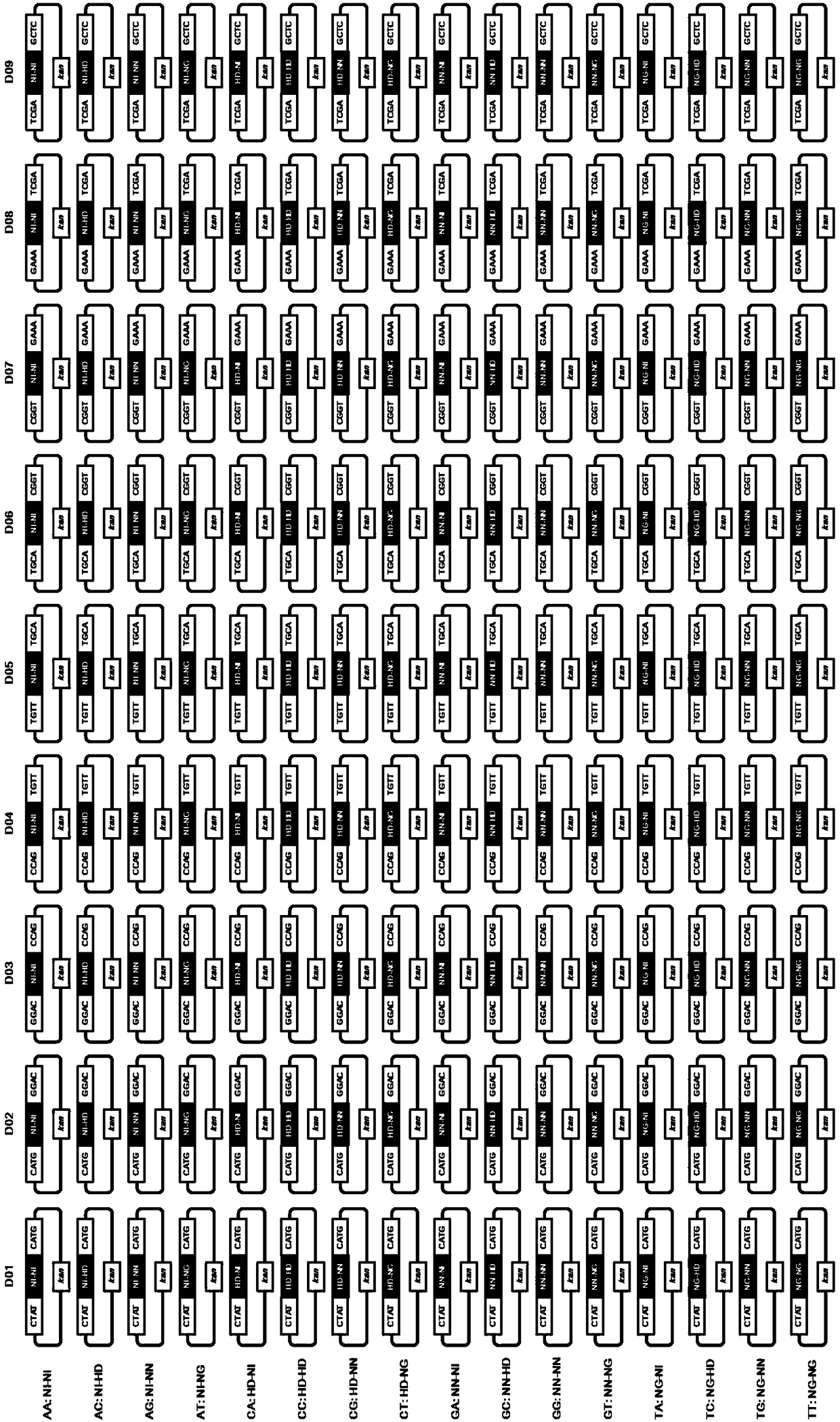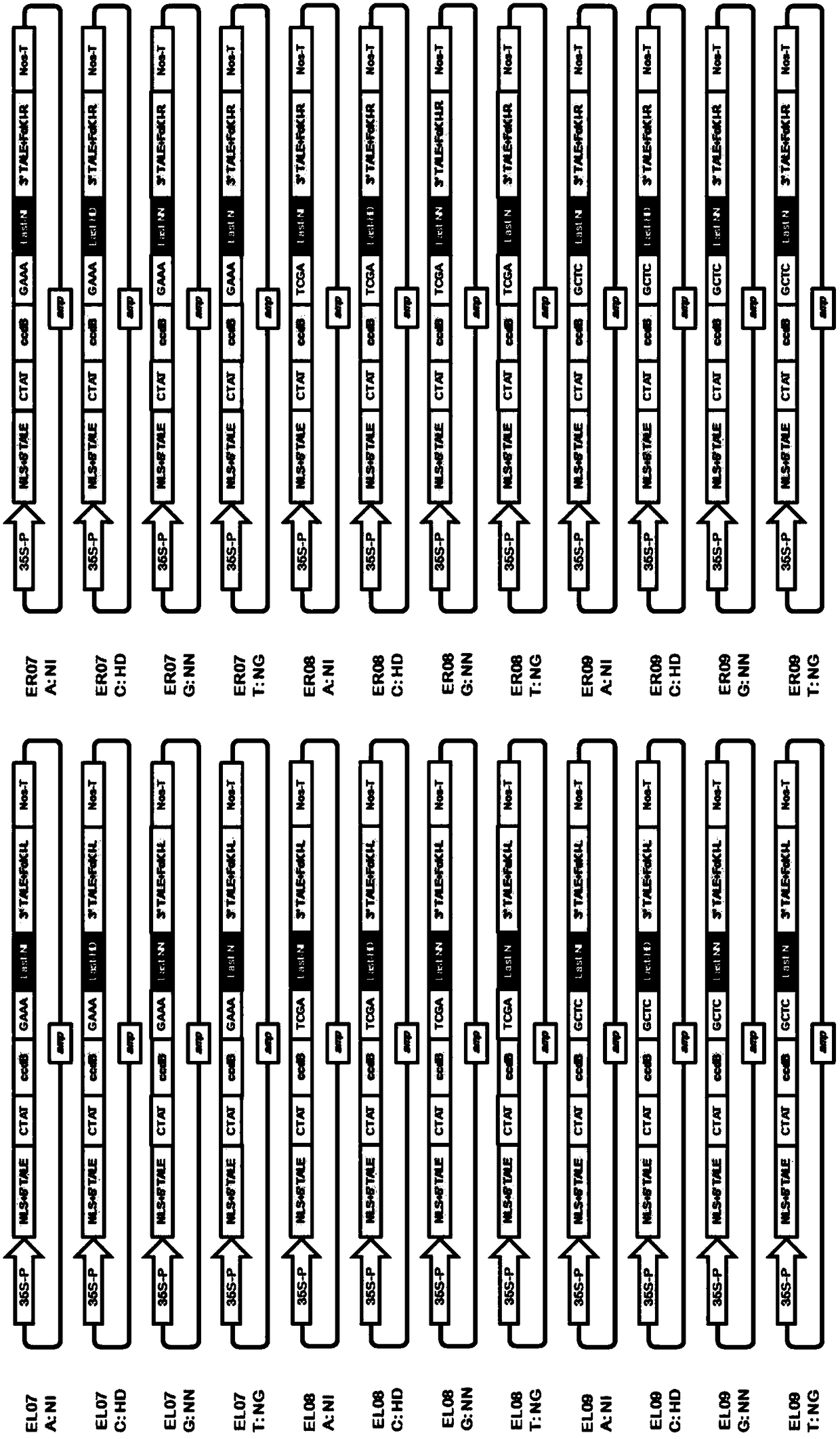A dual RVD unit module library for efficient construction of talen and its construction method
A unit module and monomer technology, applied in the field of genetic engineering, can solve the problems of limiting the high-throughput application of TALEN technology, increasing the experimental consumption, and prolonging the construction period, so as to shorten the construction time, reduce the experimental consumption, and simplify the construction steps. Effect
- Summary
- Abstract
- Description
- Claims
- Application Information
AI Technical Summary
Problems solved by technology
Method used
Image
Examples
Embodiment 1
[0035] Example 1 Basic vector construction and detection of double RVD unit library
[0036] Through artificial synthesis (commissioned by GenScript Biotechnology Co., Ltd.), 144 dual RVD unit module sequences (SEQ ID No.1D01-AA to SEQ ID No.144D09-TT) were fully synthesized, and they were constructed to pUC57 vector (purchased from GenScript), forming a double RVD unit modular plasmid vector ( figure 1 ). A series of plasmid vectors were respectively introduced into E. coli DH5a strain by heat shock method to obtain a double RVD unit module library, and the double RVD unit region of each plasmid was amplified by colony PCR method to verify the accuracy of the library. Now take the 16 carriers D04-AA to D04-TT in column D04 as examples to introduce their verification methods. Using the D04-AA bacterial solution as a template and the corresponding oligonucleotides M13F and M13R as upstream and downstream primers, the following PCR system was established: 10×Taqbuffer 5μL, dNTP Mi...
Embodiment 2
[0042] Example 2 Method and rules for assembling TALEN based on dual RVD unit modules
[0043] When using dual RVD unit modules to organize TALENs, first select the target sequence (generally 15-20 bp in length), then design the corresponding RVD, and then select the dual RVD unit module library, single RVD module library, and the last RVD skeleton expression vector Select the appropriate library vector and construct it according to the Golden Gate reaction.
[0044] The dual RVD unit module is designed according to the rules of RVD recognition of nucleotides and all possible positions. For example, the NI-NI dual RVD unit can recognize AA nucleotides. When the AA base is located in the first two positions of the target sequence, its corresponding The RVD module carrier is D01-AA: NI-NI (D01-01-AA); when the AA base is located in the third and fourth positions of the target sequence, the corresponding RVD module carrier is D02-AA: NI-NI (D02 -01-AA); and so on, all possible target...
Embodiment 3
[0051] Example 3 Assembly and activity detection of TALEN vector for targeted modification of plant endogenous genes based on dual RVD unit modules
[0052] 1. Design and assembly of TALEN vector for targeted modification of plant endogenous genes
[0053] To test the efficiency of targeted shearing and mutation of plant endogenous genes using the dual RVD unit module, the rice varieties Nipponbare OsDEP1 (GenBank NO.: FJ039904), OsBADH2 (GenBank NO.: KT993490), OsCKX2 (GenBank NO.: FJ039904), OsBADH2 (GenBank NO.: KT993490), and OsCKX2 (GenBank NO. :AB205193) gene and wheat TaMLO (GenBank NO.: KF009556) gene were used as target genes. Four pairs of TALENs were designed to specifically cut their corresponding DNA target sequences. Target gene name, target site DNA sequence (SEQ ID No. 177~184), corresponding TALEN name, RVD number, RVD sequence, and the corresponding duplex, monomer and last RVD that should be selected in the double RVD unit library Plasmid vector numbers are list...
PUM
 Login to View More
Login to View More Abstract
Description
Claims
Application Information
 Login to View More
Login to View More - R&D
- Intellectual Property
- Life Sciences
- Materials
- Tech Scout
- Unparalleled Data Quality
- Higher Quality Content
- 60% Fewer Hallucinations
Browse by: Latest US Patents, China's latest patents, Technical Efficacy Thesaurus, Application Domain, Technology Topic, Popular Technical Reports.
© 2025 PatSnap. All rights reserved.Legal|Privacy policy|Modern Slavery Act Transparency Statement|Sitemap|About US| Contact US: help@patsnap.com



